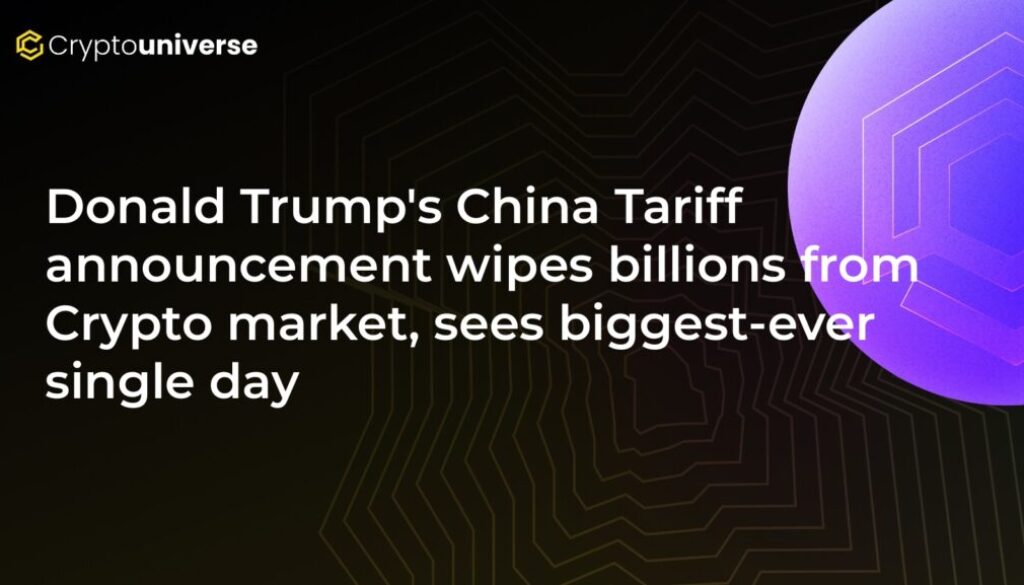Donald Trump’s China Tariff announcement wipes billions from Crypto market, sees biggest-ever single day

The Unseen Connection: How Global Politics Can Rock the Crypto World
For years, many in the crypto community have championed Bitcoin and other digital assets as a hedge against the volatility of traditional markets. The narrative is appealing: a decentralized, borderless financial system immune to the whims of politicians and central bankers. However, history often provides a stark reality check. One of the most potent examples was when a single announcement from the White House sent shockwaves through the digital asset space, proving that crypto is not the isolated island many believed it to be. The event where
This post delves into that dramatic market downturn, exploring why it happened and what it reveals about the intricate relationship between cryptocurrency and global macroeconomics.
The Tweet Heard ‘Round the World: A Market in Turmoil
The stage was set during the peak of the U.S.-China trade war. Former U.S. President Donald Trump, in a move that rattled global markets, announced his intention to impose new tariffs on billions of dollars worth of Chinese goods. The reaction in traditional markets was swift and predictable: stocks tumbled, and investors scrambled for safe-haven assets.
What surprised many, however, was the crypto market’s reaction. Instead of acting as a safe haven, Bitcoin led a market-wide plunge. In a matter of hours, major cryptocurrencies saw double-digit percentage drops. Billions of dollars in market capitalization vanished, marking one of the most significant single-day losses the industry had seen at the time. The dream of a decoupled asset was, at least for that day, shattered.
Why Did Crypto Crash? Unpacking the Chain Reaction
The crypto market’s nosedive wasn’t a random event. It was a direct consequence of broader market psychology and interconnected financial systems. Here’s a breakdown of the key factors at play:
1. A Global ‘Risk-Off’ Event
When major geopolitical tensions escalate, investors tend to reduce their exposure to high-risk assets. This is known as a “risk-off” sentiment. At the time, cryptocurrency was—and to a large extent, still is—viewed as a speculative, high-risk asset class. As global uncertainty spiked due to the tariff news, institutional and retail investors alike liquidated their riskier holdings, including stocks, emerging market assets, and cryptocurrencies, to move into more stable assets like the U.S. dollar and government bonds.
2. The Yuan Devaluation Paradox
An interesting subplot was the movement of the Chinese Yuan. In response to the tariffs, China allowed its currency to weaken past the psychologically significant level of 7 Yuan to the U.S. dollar. This led to a counter-narrative: some speculated that wealthy Chinese investors were buying Bitcoin to move their capital out of a devaluing currency. While this may have caused some initial buying pressure for Bitcoin, the overwhelming global panic and flight to safety ultimately dominated, leading to the massive sell-off.
3. The Myth of the ‘Uncorrelated Asset’
The event served as a powerful counterargument to the theory that Bitcoin is an “uncorrelated asset.” While it doesn’t always move in lockstep with the S&P 500 or NASDAQ, major macroeconomic shocks tend to impact all markets. When widespread fear grips investors, liquidity becomes king. Assets that can be sold quickly for cash (like Bitcoin) are often the first to be offloaded, linking them directly to the sentiment driving traditional markets.
Lessons from the Tariff Turmoil: Is Bitcoin Still ‘Digital Gold’?
The comparison of Bitcoin to “digital gold” stems from its shared properties with the precious metal: a finite supply, decentralization, and its potential as a store of value. However, this event highlighted a key difference: maturity and perception.
- Volatility vs. Stability: Gold has a multi-millennia track record as a safe-haven asset. During the trade war announcement, gold prices rallied as expected. Bitcoin, on the other hand, demonstrated its inherent volatility.
- Investor Behavior: In a true global crisis, the majority of capital still flows towards assets with long-established histories of stability. The crypto market is still largely driven by speculation rather than a universal belief in its safe-haven properties.
This doesn’t mean Bitcoin can’t one day achieve that status, but it shows that the journey is far from over. The market’s reaction proved that its behavior is still primarily that of a risk asset, not a risk-off hedge.
Conclusion: A More Connected Future
The market crash following Donald Trump’s tariff announcement was a watershed moment for the crypto industry. It taught a valuable lesson: in an increasingly interconnected world, no market is an island. Geopolitical events, trade policies, and central bank decisions have a tangible and often immediate impact on the price of digital assets.
For investors, this means that analyzing the crypto market in a vacuum is no longer sufficient. A deep understanding of global economics and politics is essential to navigating the volatile waters of cryptocurrency. As the asset class continues to mature and attract institutional capital, its correlation with the broader financial world is only likely to grow stronger.


